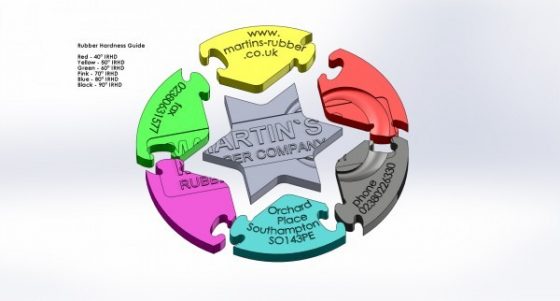How hard is Rubber? Your guide to Rubber Hardness
Posted on 01/07/2013 Category: Technical Features

One of the most difficult things to describe about Rubber is its hardness. Yes, there are internationally recognised and very well used standard test methods, such as the International Rubber Hardness Degree (IRHD), and the similar but not identical Shore “A” Hardness scale, but that is not the whole story. The various types of polymer in the “rubber” family all have their own characteristics in terms of stiffness, elasticity, snappiness, resilience and surface finish for example; the combination of these properties within any particular type of rubber dictate how it “feels” to us, and each polymer type is different. The standard test method, whether IRHD or Shore, is to press a ball of known size against a piece of rubber with a known force for a given time, and measure how much the rubber “indents” in that time – the deflection gained is then converted into a Scale of Degrees, with lower numbers such as 40° being soft (more indentation) and higher numbers such as 80° being hard (less indentation). However, the “feel” of the rubber, also known as “apparent hardness” is actually what most people want to know about when trying to decide what material might give them the kind of performance they need. This is very difficult to quantify, as, for example, a 70° Fluorocarbon (Viton) O Ring of a given size will feel very different to the same size O Ring made in 70° Silicone. It is often the case that the traditional test of squeezing a sample or pressing your fingernail into it is actually the best way to decide what general level of hardness you think you need with a given polymer, and even the most hi-tech designers sometimes seek reassurance like this. Once the range is decided, of course we then undertake much more scientific tests and controls to establish and maintain consistent manufacture of parts, but this wonderful material called rubber still demands the personal touch at times it seems. In order to help our customers when it comes to deciding how hard they need their rubber, we have created this very useful guide, consisting of a jigsaw of six different hardness pieces, which interlock into a handy desktop coaster as well. With this guide, designers and engineers can easily decide what hardness range they need to be working with, and then talk to our staff for the more specific material specifications they will need to fully define a new product. If you would like one of these Hardness Guides, please contact us with your details and we will despatch one anywhere in the world.
The post How hard is Rubber? Your guide to Rubber Hardness appeared first on Martin’s Rubber Company. Visit our tolerance guide for more information.


